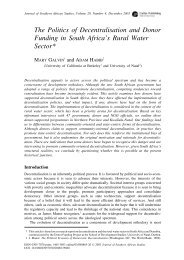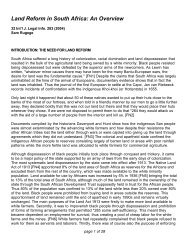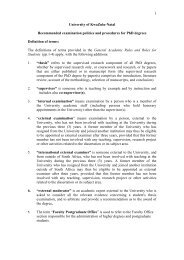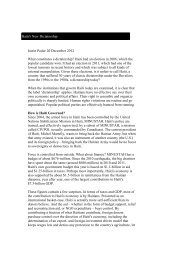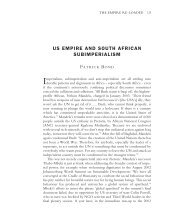Bell, Trevor : Unemployment in South Africa
Bell, Trevor : Unemployment in South Africa
Bell, Trevor : Unemployment in South Africa
You also want an ePaper? Increase the reach of your titles
YUMPU automatically turns print PDFs into web optimized ePapers that Google loves.
ates had been recorded only <strong>in</strong> 1956 and 1972. Alao, the employment<br />
growth peaks of 1980 and 1981 were clearly much lover than earlier<br />
peaks. Indeed, <strong>in</strong> terms of employment growth the upsw<strong>in</strong>g of 1979-81<br />
was the weakest cyclical bmm s<strong>in</strong>ce the upsw<strong>in</strong>g of 1956-1959.<br />
TO put these results <strong>in</strong> absolute terms, the four non-agricultural<br />
sectors with which we have been deal<strong>in</strong>g provided Blacks with an extra<br />
380 000 jobs between 1970 and 1982, that is, only some 32 000 per<br />
annum. Tak<strong>in</strong>g <strong>in</strong>to account the rest of the non-agricultural sectors<br />
(trade, transport and communication, f<strong>in</strong>ance and <strong>in</strong>surance, and<br />
servicesl, it appears that total non-agricultural employment<br />
<strong>in</strong>creased by 724 700 over this twelve year period, that ia, by about<br />
60 000 per annum. Compared with this the Black labour supply<br />
<strong>in</strong>creased by an estimated 1487000 between 1970 and 1982, that is, by<br />
about 125 000 per annum.<br />
What is absolutely clear from the evidence considered above is that<br />
there has been a very marked decl<strong>in</strong>e <strong>in</strong> the rate of growth of fo-1<br />
sector, non-agricultural, employment, and we <strong>in</strong>terpret thia as a<br />
marked decl<strong>in</strong>e <strong>in</strong> the demand for labour <strong>in</strong> these formal, nonagricultural<br />
sectors. Furthermore, we have suggested that the<br />
movements <strong>in</strong> the unemployment rate are consistent with the<br />
relationship between formal, non-agricultural employment growth and<br />
population growth rates illustrated <strong>in</strong> Figure 3.<br />
ii) 'Ihe long-term ris<strong>in</strong>g trend <strong>in</strong> the unemployment rate thus has to do<br />
with a fall <strong>in</strong> the rate of growth <strong>in</strong> the demand for labour, rather<br />
than with any shift <strong>in</strong> labour supply. But the question rema<strong>in</strong>s, what<br />
produced the slowdown <strong>in</strong> the demand for labour? There are various<br />
possibilities, but one very widespread and important view is that it<br />
is largely due to factor-market distortions which, by lower<strong>in</strong>g the<br />
cost of us<strong>in</strong>g capital equipment relative to the cost of us<strong>in</strong>g labour,<br />
encourage the substitution of capital for labour, thereby reduc<strong>in</strong>g<br />
the demand for labour. Prom<strong>in</strong>ent amongst these distortions are<br />
overvalued exchange rates and low real <strong>in</strong>terest rates, due to




